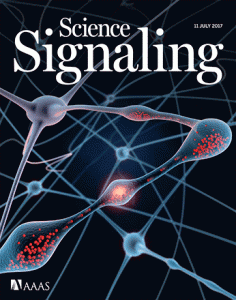 Science Signaling has issued an expression of concern for a 2016 paper, citing an institutional investigation into image manipulation.
Science Signaling has issued an expression of concern for a 2016 paper, citing an institutional investigation into image manipulation.
According to a spokesperson for the journal, the corresponding author, Tanya Kalin, became concerned that two images in the paper had been manipulated. Kalin then notified the research integrity officer at Cincinnati Children’s Hospital Medical Center, where she is based.
On May 9 2017, Kalin alerted the journal to the investigation. A week later, the hospital’s research integrity officer followed up with the journal, flagging the figures under question. The journal then prepared an expression of concern (EOC) to alert readers to the issues and the institution’s investigation.
Here’s the EOC notice for “The transcription factor FOXF1 promotes prostate cancer by stimulating the mitogen-activated protein kinase ERK5:”
In the 10 May 2016 issue, Science Signaling published the Research Article “The transcription factor FOXF1 promotes prostate cancer by stimulating the mitogenactivated protein kinase ERK5” by L. Fulford, D. Milewski, V. Ustiyan, N. Ravishankar, Y. Cai, T. Le, S. Masineni, S. Kasper, B. Aronow, V. V. Kalinichenko, T. V. Kalin (1). The corresponding author and the research integrity officer of the corresponding author’s institution notified Science Signaling that there was concern about image manipulation in Fig. 2C (images of caspase-3 staining) and fig. S4E (Western blots) and that an investigation is under way to determine if this represents research misconduct and to examine the data in other figures of the paper. Science Signaling is publishing this Editorial Expression of Concern to alert our readers while we await the outcome of the investigation.
The 2016 paper — which found that a specific protein fuels tumor growth in prostate cancer — has been cited two times, according to Clarivate Analytics’ Web of Science.
The spokesperson, who spoke on behalf of the journal’s editor, John Foley, told us:
Science Signaling is currently looking into how the duplications occurred. This matter was brought to the journal’s attention when the corresponding author developed concerns about the figures in question, brought those concerns to the Research Integrity Officer at Cincinnati Children’s Hospital Medical Center, who conducted an inquiry and then set up an investigation. The corresponding author then notified the journal.
The spokesperson also told us:
The corresponding author Dr. Kalin first notified Science Signaling via email on May 9th that the paper was under investigation.
…the journal then received a note from the Research Integrity Officer on May 16th outlining the particular figures that were of concern. Shortly thereafter, newly appointed Editor Dr. John Foley began the process of preparing the Editorial Expression of Concern.
The spokesperson added:
While the journal plans to investigate the data in the other figures, Science Signaling intends to await the outcome of the investigation by the Research Integrity Officer, so that a comprehensive and clear analysis of the data can be made.
We reached out to the Kalin. We also contacted the research integrity officer at Cincinnati Children’s Hospital Medical Center, and received this response from a spokesperson:
As required by federal regulations, we must maintain confidentiality at this time.
Like Retraction Watch? Consider making a tax-deductible contribution to support our growth. You can also follow us on Twitter, like us on Facebook, add us to your RSS reader, sign up on our homepage for an email every time there’s a new post, or subscribe to our daily digest. Click here to review our Comments Policy. For a sneak peek at what we’re working on, click here.
We reached out to the Kalin.
Are you sure?
Thanks for pointing out. Fixed.
Looks like possible duplication in Fig 2C. The control and FoxF1 histology image is the same, but one is shifted slightly. The Western in S4 is a bit more blatant. By eye the actin panel for 22RV1 has been flipped and rotated and used for total ERK5 in the C4-2B panel. Also, pERK5 and WNK1 blots in 22RV1 and C4-2B look very similar.